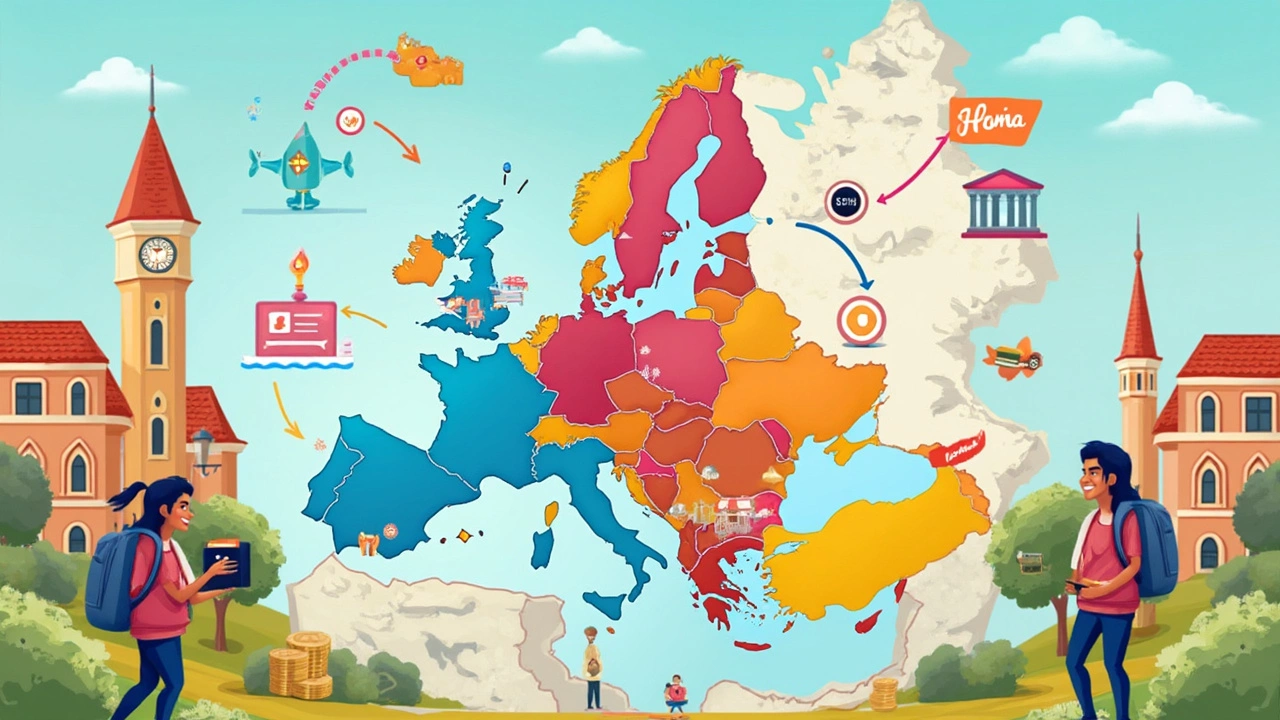What Country Pays You to Study? Your Guide to Tuition-Free Education Abroad

Scrolling through Instagram and seeing a friend studying in Europe, I wondered—can you actually get paid to study abroad? Turns out, some countries don't just make university free for international students—they'll toss in a monthly stipend. That means you could cover rent, food, maybe even have enough left over for a train trip or two. No student loan panic? That sounds like winning the lottery in slow motion.
Right now, options like Norway, Germany, and a few other places have programs where you pay zero tuition and can even snag monthly payments for living expenses. Sometimes these are direct payments, sometimes they involve working part-time on campus, but the bottom line is: you can get financial help as a student from countries that believe education should open doors—not slam you into debt.
- Countries That Offer Stipends or Free Tuition
- How Do These Programs Work?
- Famous Examples: Norway, Germany, and More
- What’s the Catch? Real Talk About Life and Applying
- Tips for Scoring a Spot and Succeeding
Countries That Offer Stipends or Free Tuition
If you’re hunting for places where you can either study for free or actually get paid as a student, you have legit choices—mostly in Europe, but also in some surprise spots. Here’s what’s real, not just what you hear in passing on TikTok.
The study abroad dream gets serious when you look at countries like Norway, Germany, Denmark, Sweden, and Finland. In Norway, public universities charge zero tuition fees for everyone—including international students. The only catch? You still need to cover living costs, but the government figures that out, too. Bachelor’s and master’s degrees are totally open, and the Norwegian State Educational Loan Fund sometimes offers stipends—even to non-Europeans if you fit certain programs.
Germany’s famous for free tuition at most public universities. International students just need to pay a small “semester contribution” for admin and public transport, usually under €300. Some German states and DAAD scholarships offer a monthly living allowance. In my experience, you won’t get rich, but you definitely won’t be scraping by like students in some other countries.
In Denmark and Sweden, the tuition-free rule mainly applies to students from the EU/EEA, but there are huge government scholarships (like the Swedish Institute Scholarships) for others. If you snatch one, you’ll get your fees paid and receive a monthly payout for rent, groceries, and basics. Finland also offers free education to EU/EEA students, and everyone else can apply for full-tuition waivers and living stipends, depending on the course and university.
"We believe talent should not depend on background or wallet, which is why our top students—even from overseas—often qualify for generous scholarships and stipends." — Swedish Institute Scholarship Office
Some Asian countries are also starting to join this trend. For example, Taiwan and South Korea have government-funded programs (like the Korean Government Scholarship Program) that cover tuition and offer monthly allowances. You can even get money for plane tickets.
Here’s a simple look at what you might expect from the main players:
| Country | Tuition Fee | Monthly Stipend (Typical) |
|---|---|---|
| Norway | Free | Up to NOK 11,500 (~$1,050) |
| Germany | Free (small semester fee) | €850–€1,200 via scholarships |
| Sweden | Free for EU/EEA; scholarships for others | SEK 10,000–12,000 (~$950–$1,100) for scholars |
| Denmark | Free for EU/EEA; scholarships for others | DKK 6,000–8,000 (~$850–$1,150) for scholars |
| Finland | Free for EU/EEA; waivers available | €700–€1,000 with grants |
| Taiwan | Low; scholarships available | NT$15,000–NT$20,000 (~$490–$660) |
| South Korea | Low; scholarships available | KRW 900,000 (~$700) |
Before packing your bags, check local rules. Not every university has the same setup, and your field of study matters. The cool part? If you play your cards right, your biggest expense might be choosing which country’s food you like best.
How Do These Programs Work?
It sounds almost too good to be true: fly off to a new country, sign up for college, and get help with your bills. But these "get paid to study abroad" deals usually work in pretty clear ways. Here’s what you’ll actually face when you apply and show up for the first day of class.
Some countries (like Norway) offer free tuition to everyone—doesn’t matter if you’re local or coming from halfway across the world. Germany does this at nearly all public universities, though in some states, non-EU students might pay a small fee (way lower than US rates).
Funding for your living expenses comes in a couple of flavors:
- Government Scholarships: Some spots, like Finland, Sweden, or Denmark, have public scholarships meant for foreign students. These usually pay a monthly stipend to help with food, rent, and transport.
- University Grants: Plenty of universities set aside cash for international students who have top grades or special talents. This is money you don’t have to pay back.
- Research or Teaching Assistant Jobs: Especially for master's or PhD students, you might score a job helping with classes or research. The pay here can actually cover more than your basics some months.
So how much money are we talking about?
| Country | Monthly Stipend (USD) | Tuition for International Students |
|---|---|---|
| Norway | $1,100 to $1,200 | Free |
| Germany | $900 to $1,100 | Usually Free or <$1,000/year |
| Finland | $500 to $900 | Free with scholarship |
Most of these stipends are just enough to keep the fridge stocked and cover rent if you budget. The key is that you don’t come home feeling trapped by massive debt. Each country has different application steps, but you’ll usually need to:
- Apply to your chosen university (often with translated transcripts, language test scores, a motivation letter, and a CV).
- Check if you qualify for government or university scholarships—deadlines here can be months before school starts.
- Show proof you can cover your stay (even with tuition covered, you’ll often need to put money in a local bank as proof).
- If you land a stipend, follow the rules—sometimes you need to maintain certain grades or take a set number of credits each semester.
If you’re wondering whether you can work part-time as well, most of these places let you pick up a student job. That’s not usually counted as part of your government stipend but adds a cushion for travel or fun.

Famous Examples: Norway, Germany, and More
Let’s be real—Norway is the poster child for getting a free education abroad. Public universities in Norway don’t charge tuition fees to international students, no matter where you’re from. Pick a program, meet admission requirements, and you’re in. The only big cost is living expenses. This isn’t just a marketing trick; it’s their philosophy. The Norwegian State Educational Loan Fund also offers grants and loans if you study in Norwegian. If you’re not fluent, many master’s programs are in English, so that’s a win.
Germany is close behind, famous for scrapping university tuition for everyone (yes, really). Even if you’re from overseas, you only pay a small semester fee—often under €300. Plus, certain scholarships like DAAD (Deutscher Akademischer Austauschdienst) drop monthly stipends in your bank account, generally from €850 up to €1,200 if you're at the PhD level. Most students can also work up to 20 hours a week.
Take a look at how these countries compare:
| Country | Tuition Fees for International Students | Living Stipend/Scholarships | Language Requirements |
|---|---|---|---|
| Norway | None | Limited grants for programs in Norwegian; living expenses often on you | English or Norwegian |
| Germany | Usually None (except Baden-Württemberg region ~€1,500/year) | DAAD, Erasmus+, university/region scholarships | German or English |
| France | Very low (~€170–€380/year) | Eiffel and Ampère Excellence scholarships, up to €1,200/month | Mostly French, some English |
| Finland | Free for EU/EEA, €4,000–€18,000/year for others | Uni-level scholarships cover up to 100% of tuition plus some living support | English or Finnish/Swedish |
What about places outside Europe? There are a few. Brazil offers some free education, especially at public universities—but you’ll need Portuguese. Saudi Arabia’s top universities offer full-ride scholarships to international students and even pay for flights home. And China’s CSC Scholarship covers tuition, dorms, insurance, plus a monthly stipend (about 2,500 RMB for undergrads, which is around $350).
- study abroad students in these countries often report more independence and less financial stress compared to studying in places like the US or Australia.
- But snagging a spot isn’t automatic—most universities still want to see solid grades and language skills.
- And don’t forget about visa requirements—some countries need proof you can handle living costs first.
Bored of the “broke college student” life? With the right country and a little paperwork, you could actually come out ahead.
What’s the Catch? Real Talk About Life and Applying
Getting paid to study abroad sounds like a dream, but there’s more to the story. The truth? These programs aren’t just handing out cash for nothing. For starters, the application process for tuition-free education or stipends can be a huge hurdle—loads of paperwork, proof of language skills, and competition from students worldwide all looking for the same deal. Norway, for example, offers free tuition to everyone, but most classes for bachelor’s programs are in Norwegian. You’ll need to prove you speak it pretty well, or your options shrink fast.
Now, let’s talk study abroad life. Those monthly stipends in countries like Germany can help, but they won’t have you living large. Germany’s DAAD scholarship pays about €934 (roughly $1,000) a month. It’s enough to cover basic costs, but things like rent and food aren’t cheap in cities like Berlin or Munich. Here’s a quick look at what you might spend:
| Country | Average Monthly Student Living Expenses | Typical Monthly Stipend/Scholarship |
|---|---|---|
| Germany | €850 - €1,200 | €934 (DAAD) |
| Norway | €1,200 - €1,600 | No standard stipend, but some universities offer aid |
| Finland | €700 - €1,000 | Varies (University-specific) |
Your stipend probably won’t cover trips home, new phones, or late-night pizza runs. Most countries will actually require you to prove you’ve got backup savings before issuing a student visa. Norway expects you to show around €13,700 in your account for a year of study as proof you can handle the high cost of living.
Language requirements trip up a lot of folks. If you’re not fluent, you’ll need to find programs taught in English—usually at the master’s level and often more competitive. Some places make you take a language test like the IELTS or TestDaF. I tried a Norwegian language course online once for fun, and trust me, it’s no walk in the park.
Finally, even with all this paperwork and planning, there are cultural adjustments. You might have to cook more (no cheap cafeteria food everywhere), wrestle with confusing government forms, or feel homesick on rainy days. But if you push through the hassle, the payoff is huge—quality education, less debt, and a chance to actually live abroad. Just be ready to work for it.
- Keep your deadlines organized—missing one can ruin your plans.
- Figure out the visa requirements early; they change often.
- Check if you’re allowed to work part-time—most countries limit it to 20 hours a week during term.
- Join Facebook groups for international students in your target country. They’ll tell you what’s really up with renting, food prices, and fitting in.

Tips for Scoring a Spot and Succeeding
Want in on those tuition-free or stipend deals? Getting there takes more than surfing the web and filling out quick forms. Here's how real people end up living that dream and grabbing those cash offers to study abroad.
- study abroad applications are super competitive in countries like Germany and Norway. In 2024, the German Academic Exchange Service (DAAD) reported that less than 30% of foreign student applications were accepted for their major masters’ grants. So, triple-check every single requirement and apply early.
- Focus on your grades. Countries handing out stipends or free tuition want people who can handle the work. For Germany, a solid GPA and strong reference letters matter more than you think.
- Directly contact universities' international offices. People there often have the latest updates on scholarships and application tricks. I've heard from students who got inside tips that way, like finding out about last-minute grants that never show up on official websites.
- Get your documents sorted and translated. Most European countries need official records, and they want certified translations if your papers aren’t in English or their language.
- Practice your language skills—even if your course is in English. Daily life in Norway or Germany happens in the local tongue, and knowing basics goes a long way in feeling at home (plus, some programs check language skills at entry).
- Don’t forget proof of funds. Even with stipends, most places (like Norway) require you to show up-front savings. In 2025, Norway expects foreign students to show NOK 137,907 (about $12,600 USD) in their bank statement for a year.
Once you land your spot, the next test is day-to-day reality. Many students juggle part-time work, school, and managing tight budgets. Planning ahead helps you handle surprise expenses, like extra health insurance or pricey textbooks.
| Country | Main Language | Proof of Funds Needed (USD, 2025) | Chance of Acceptance (%) |
|---|---|---|---|
| Germany | German/English | $11,500 | ~30 |
| Norway | Norwegian/English | $12,600 | ~15 |
| Finland | Finnish/English | $8,500 | ~20 |
Remember: don’t skip the basics. Get your visa sorted, read up on health insurance, and talk to students already there—online groups are full of unfiltered advice. The grind can be tough, but if you stick with it, you could end up not just debt-free, but with a global network and some crazy stories to tell your kids one day.
